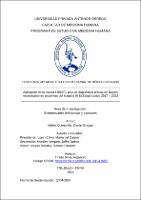Mostrar el registro sencillo del ítem
Aplicación de la escala LRINEC para el diagnóstico precoz de fascitis necrotizante en pacientes del hospital III EsSalud Iquitos 2017 – 2023
| dc.contributor.advisor | Tirado Silva, Alejandro | |
| dc.contributor.author | Müller Quintanilla, Daniel Brayan | |
| dc.creator | Müller Quintanilla, Daniel Brayan | |
| dc.date.accessioned | 2024-05-02T21:07:00Z | |
| dc.date.available | 2024-05-02T21:07:00Z | |
| dc.date.issued | 2024 | |
| dc.identifier.uri | https://hdl.handle.net/20.500.12759/28031 | |
| dc.description.abstract | Introducción: La fascitis necrotizante es un tipo de infección de piel y tejidos blandos que suele extenderse tanto en la superficie como en la profundidad de los tejidos además de tener manifestaciones silenciosas y poco específicas que generan un compromiso mortal. De allí parte la necesidad de encontrar una herramienta que permita el diagnóstico precoz usando componentes de fácil acceso en cualquier nivel hospitalario como lo representa la escala LRINEC. Objetivos: Determinar la capacidad predictiva de la escala LRINEC para el diagnóstico de fascitis necrotizante en pacientes del Hospital III EsSalud de Iquitos 2017-2023. Métodos: Se recolectó datos a partir de la revisión de historias clínicas de pacientes con infección de piel y partes blandas del hospital III EsSalud de Iquitos utilizándose un muestreo por conveniencia. Posteriormente, se les aplicó la escala LRINEC para evaluar el riesgo de padecer fascitis necrotizante y así evaluar la capacidad predictiva de la escala. Por tanto, se realizó el análisis estadístico mediante el cálculo de Chi cuadrado, Odds ratio y curva ROC. Resultados: Según la curva ROC, la escala LRINEC tiene una buena capacidad predictiva en este estudio ya que tuvo una sensibilidad del 87.5% y una especificidad del 85.11%. El punto de corte obtenido mediante el análisis fue de 5.5, redondeado es equivalente a 6 puntos. En cuanto a la edad fue mayor a 50 años con un 39.8%. Por otro lado, el sexo masculino predominó más para tener un diagnóstico de fascitis necrotizante sin tener comorbilidades. Los valores de los ODDS RATIO, estimados a partir de los coeficientes de regresión, indican que el riesgo relativo de un paciente que tiene comorbilidades es 2.138 veces más propenso de tener fascitis necrotizante del que no presenta comorbilidades; así como también, el riesgo relativo de un paciente que tenga edad más avanzada es 1.018 veces más propenso de tener fascitis necrotizante del que tiene una edad menos avanzada. Conclusiones: La escala LRINEC tuvo una buena capacidad predictiva para el diagnóstico de fascitis necrotizante en pacientes del hospital III EsSalud de Iquitos en el periodo 2017 - 2023 | es_PE |
| dc.description.abstract | Introduction: Necrotizing fasciitis is a type of skin and soft tissue infection that usually spreads both on the surface and in the depths of the tissues. It also has silent and non-specific manifestations that generate a fatal compromise. Therefore, the need to find a tool that allows early diagnosis using easily accessible components at any hospital level, as represented by the LRINEC score, arises. Objective: To determine whether the LRINEC scale is effective for the diagnosis of necrotizing fasciitis in patients of hospital III EsSalud de Iquitos 2017-2023. Methods: The data was collected from the review of medical records of patients with skin and soft tissue infection (cellulitis) at Hospital III EsSalud - Iquitos using convenience sampling. Subsequently, the LRINEC score was applied to evaluate the risk of suffering from Necrotizing fasciitis and thus evaluate the scale's predictive capacity. Therefore, statistical analysis was performed by calculating the Chi-square, Odds Ratio, and ROC Curve. Results: According to the ROC curve, the LRINEC scale has a good predictive capacity in this study since it had a sensitivity of 87.5% and a specificity of 85.11%. The cut-off point obtained through the analysis was 5.5, rounded is equivalent to 6 points. Regarding age, it was greater than 50 years with 39.8%. On the other hand, the male sex predominated more to have a diagnosis of necrotizing fasciitis without having comorbidities. The ODDS RATIO values estimated from the regression coefficients indicate that the relative risk of a patient with comorbidities is 2.138 times more likely to have necrotizing fasciitis than a patient without comorbidities, and the relative risk of a patient with older age is 1.018 times more likely to have necrotizing fasciitis than a patient with younger age. Conclusions: From 2017 to 2023, the LRINEC score had a good predictive capacity for diagnosing necrotizing fasciitis in Hospital III EsSalud - Iquitos patients | es_PE |
| dc.description.uri | Tesis | es_PE |
| dc.format | application/pdf | es_PE |
| dc.language.iso | spa | es_PE |
| dc.publisher | Universidad Privada Antenor Orrego | es_PE |
| dc.relation.ispartofseries | T_MED_3819 | |
| dc.rights | info:eu-repo/semantics/openAccess | es_PE |
| dc.rights.uri | https://creativecommons.org/licenses/by/4.0/ | es_PE |
| dc.subject | Fascitis necrotizante | es_PE |
| dc.subject | escala LRINEC | es_PE |
| dc.subject | diagnóstico | es_PE |
| dc.title | Aplicación de la escala LRINEC para el diagnóstico precoz de fascitis necrotizante en pacientes del hospital III EsSalud Iquitos 2017 – 2023 | es_PE |
| dc.type | info:eu-repo/semantics/bachelorThesis | es_PE |
| thesis.degree.grantor | Universidad Privada Antenor Orrego. Facultad de Medicina Humana | es_PE |
| thesis.degree.name | Médico Cirujano | es_PE |
| thesis.degree.discipline | Medicina Humana | es_PE |
| dc.subject.ocde | http://purl.org/pe-repo/ocde/ford#3.02.27 | es_PE |
| renati.advisor.orcid | https://orcid.org/0000-0001-6104-9455 | es_PE |
| renati.author.dni | 72371776 | |
| renati.advisor.dni | 18123592 | |
| renati.type | http://purl.org/pe-repo/renati/type#tesis | es_PE |
| renati.level | http://purl.org/pe-repo/renati/level#tituloProfesional | es_PE |
| renati.discipline | 912016 | es_PE |
| renati.juror | Lujan Calvo, María del Carmen | |
| renati.juror | Morales Vergara, Joffre Jareck | |
| renati.juror | Vargas Morales, Renan Estuardo | |
| dc.publisher.country | PE | es_PE |
Ficheros en el ítem
Este ítem aparece en la(s) siguiente(s) colección(es)
-
Medicina Humana [2774]




